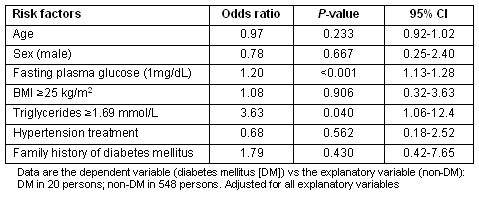Dear Editor
The Tottori-Kofu Study was intended to assist in preventing stroke in the rural town of Kofu, Tottori Prefecture, Japan (Fig1), where the incidence of cerebral stroke was 3 times higher than the national average. One aim of the study was to develop an effective screening method for diabetes mellitus (DM), a major risk factor for stroke.
In Japan, the diagnostic criteria for glucose intolerance has been defined as a fasting plasma glucose (FPG) level of ≥6.1 mmol/L (110 mg/dL). The cutoff point for FPG was found to be optimal at 6.2 mmol/L in the urban area of Hisayama (sensitivity 78-81%); however, in rural Funagata the sensitivity was found to be low at 6.1 mmol/L (64%)1,2. Based on these results it was hypothesized that the rural Japanese population requires different FPG criteria and measures of other risk factors compared with their urban counterparts. This was tested in the town of Kofu.

Figure 1: The rural town, Kofu, Japan - site of the research.
In 2005, 734 residents of the town of Kofu received a basic medical examination. Their mean age was 66.4 years; mean BMI was 22.7 kg/m2; FPG 5.07 mmol/L; HbA1c (NGSP) 5.59%; and fasting triglycerides 1.16 mmol/L (all mean values). Residents who met any of the following criteria underwent an oral glucose tolerance test (OGTT): FPG ≥5.5 mmol/L or HbA1c (NGSP) ≥5.9%, BMI ≥25 kg/m2, triglycerides ≥1.69 mmol/L (150 mg/dL), currently being treated for hypertension, or a family history of DM.
The authors performed a multiple regression analysis and receiver operating characteristic (ROC) analysis of the data. It was presumed that non-DM subjects were individuals with normal glucose tolerance and impaired glucose tolerance in OGTT. From a past report3, subjects believed to have an extremely low probability of having DM at examination were individuals with FPG <5.5 mmol/L and HbA1c (NGSP) <5.9%, BMI <25 kg/m2, triglycerides <1.69 mmol/L, no family history of DM, and no reported treatment for hypertension.
Only 4 subjects were newly diagnosed with DM (FPG ≥7.0 mmol/L [126 mg/dL]) following the basic medical examination. Of the 220 persons who underwent OGTT, 20 subjects were detected to have DM. Multiple regression analysis indicated that elevated FPG (per 1 mg/dL) and triglycerides (≥1.69 mmol/L) were significant risk factors for DM (FPG: OR=1.20, 95%CI:1.13-1.28; triglycerides: OR=3.63, 95%CI: 1.06-12.4) (Table 1). The optimal FPG cut-off for DM was 5.2 mmol/L (94 mg/dL), based on ROC analysis (sensitivity 85%, specificity 78%, area under the curve [AUC] 0.880). Consumption of alcohol was significantly higher (>23 g ethanol >3 times/week) in the DM group compared with the non-DM group (65% vs 33.7%, p<0.005, χ2 test). The mean triglycerides level was significantly higher in the group of drinkers compared with non-drinkers (1.22 mmol/L vs 1.13 mmol/L, p<0.05, unpaired t-test).
Table 1: Odds ratios for diabetes mellitus by multiple logistic regression analysis

These results suggest that FPG of ≥6.1 mmol/L alone is insufficient to detect early-stage DM. The combination of FPG ≥5.2 mmol/L and triglycerides ≥1.69 mmol/L was found to be useful as a screening to detect early-stage DM in the group studied. While the suggested FPG criteria may have been too low, it was useful to also consider OGTT results, especially in those with hypertriglyceridemia. It is speculated that moderate alcohol consumption induced diabetes and hypertriglyceridemia in the population studied4,5.
The study results should, however, be interpreted with care as it was cross-sectional rather than a cohort study, and the subset of residents who underwent the OGTT was biased. Moreover, the Kofu town residents were an elderly population, so the criteria may not be applicable to other rural areas in Japan. However, it is predicted that the screening criteria established in the present study will contribute to the prevention of stroke in the specific population studied, and may also be useful to consider for other rural residents in the vicinity of the rural town of Kofu.
Tsuyoshi Ohkura PhD, MD1, Shin-ichi Taniguchi PhD, MD2,
Yoneatsu Osaki PhD, MD3, Naoya Yamamoto MD1, Keisuke Sumi MD1,
Youhei Fujioka MD1, Kazuhiko Matsuzawa MD1, Shoichiro Izawa MD1,
Hideki Shiochi MD1, Hiroshi Kinoshita PhD, MD1, Kazuoki Inoue PhD, MD1,
Mikio Takechi PhD, MD4, Takuji Kishimoto PhD, MD3, Chiaki Shigemasa PhD, MD1
Departments of 1Multidisciplinary Internal Medicine,
2Regional Medicine and 3Social Medicine,
Faculty of Medicine, Tottori University, Yonago,
4Ebi Clinic, Hino-gun, Tottori, Japan
References
1. Doi Y, Kubo M, Yonemoto K, Ninomiya T, Iwase M, Kiyohara Y et al. Fasting plasma glucose cutoff for diagnosis of diabetes in a Japanese population. Journal of Clinical Endocrinology and Metabolism 2008; 93(9): 3425-3429.
2. Nakagami T, Tominaga M, Nishimura R, Daimon M, Oizumi T, Tajima N. Is the measurement of glycated hemoglobin A1c alone an efficient screening test for undiagnosed diabetes? Japan National Diabetes Survey. Diabetes Research and Clinical Practice 2007; 76(2): 251-256.
3. Ko GT, Chan JC, Li JK. Combined use of a fasting plasma glucose concentration and HbA1c or fructosamine predicts the likelihood of having diabetes in high-risk subjects. Diabetes Care 1998; 21(8): 1221-1225.
4. Waki K, Noda M, Sasaki S, Isogawa A, Kadowaki T, Tsugane S et al. JPHC Study Group. Alcohol consumption and other risk factors for self-reported diabetes among middle-aged Japanese: a population-based prospective study in the JPHC study cohort I. Diabetes Medicine 2005; 22(3): 323-331.
5. Sereny G, Endrenyi L. Mechanism and significance of carbohydrate intolerance in chronic alcoholism. Metabolism 1978; 27(9): 1041-1046.

